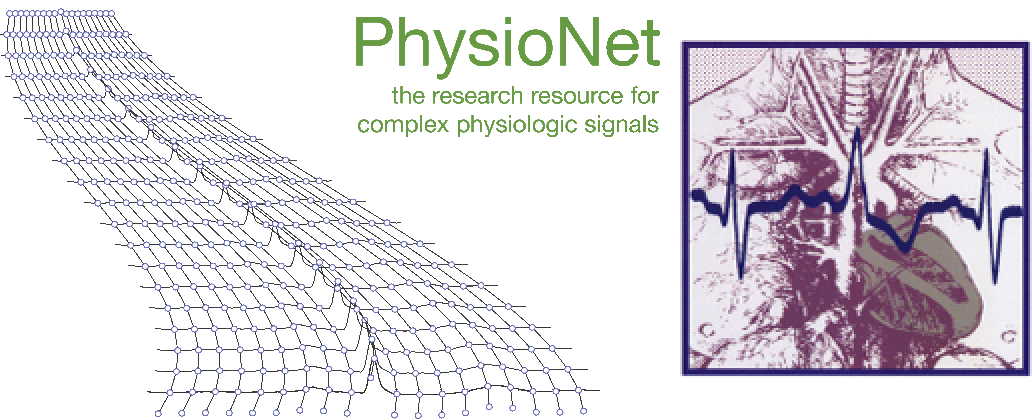- Registration form
- Example MATLAB and Python submissions and scoring code
- Submission instructions and form
- Leaderboard, results, and papers
- Public discussion forum
- Rules and deadlines
- Current and general FAQs
- About
Seth McClennen, MD
Ary L. Goldberger, MD
Beth Israel Deaconess Medical Center
Boston, MA USA
George B. Moody
Harvard-MIT Division of Health Sciences and Technology
Cambridge, MA USA
The general objective of the Computers in Cardiology Challenge 2001 is to characterize changes in the surface electrocardiogram immediately prior to the onset of paroxysmal atrial fibrillation (PAF), in an effort to develop a reliable prediction algorithm for the arrhythmia.
Currently, no reliable validated methods exist to predict the onset of PAF. Twelve-lead electrocardiograms [1], signal-averaged P-wave morphology [2,3], R-R interval dynamics [4,5], and atrial ectopy [5-7] have all been studied as possible predictors of the onset of PAF. Sensitive and specific non-invasive markers predicting the onset of PAF have not been determined or independently validated, however. Given recent advances in clinical electrophysiology, a prediction tool that would allow for detection of imminent atrial fibrillation may have future therapeutic ramifications.
Atrial fibrillation (AF) is the most common major cardiac arrhythmia. In the United States alone, it affects an estimated 2.2 million people, with an increasing prevalence in the elderly [8]. As the population ages, the prevalence is expected to rise; currently approximately 6% of the US population over the age of 65 are diagnosed with this arrhythmia. Management consists of heart rate control and/or prevention of recurrent fibrillation, as well as prevention of secondary complications (most often thromboembolism). Paroxysms of atrial fibrillation often precede the onset of more sustained atrial fibrillation. A Japanese study of 234 patients with atrial fibrillation found that 94 (40%) had PAF, and that sustained atrial fibrillation developed within one year in approximately one fourth of patients with PAF [9].
The development of accurate predictors of the acute onset of PAF is clinically important because of the increasing possibility of electrically stabilizing and preventing the onset of atrial arrhythmias with different atrial pacing techniques. Dual chamber atrial pacing may reduce the heterogeneity of atrial refractoriness manifested by P-wave duration changes on the surface electrocardiogram recording. Preliminary studies by Prakash and colleagues [10] have indicated that acute suppression of PAF is possible in selected patients with dual-site right atrial pacing from the coronary sinus ostium and high right atrium. The advances in anti-tachycardia pacing, drug management, and defibrillation may be applied to prevent the acute onset of PAF prior to the loss of sinus rhythm. The maintenance of sinus rhythm can lead to decreased symptoms, improved hemodynamics, and possibly a decrease in the atrial remodeling that causes increased susceptibility to future episodes of PAF [11]. In addition, there may be a reduction in the risk of thromboembolic events.
References
- Dilaveris PE, Gialafos, EJ, Sideris SK, Theopistou AM, Andrikopoulos GK, Kyriakidis M, Gialafos JE, Toutouzas PK. Simple electrocardiographic markers for the prediction of paroxysmal idiopathic atrial fibrillation. Am Heart J 1998;135:733-738.
- Ishimoto N, Ito M, Kinoshita M. Signal-averaged P-wave abnormalities and atrial size in patients with and without idiopathic paroxysmal atrial fibrillation. Am Heart J 2000;139:684-689.
- Amar D, Roistacher N, Zhang H, Baum MS, Ginsburg I, Steinberg JS. Signal-averaged P-wave duration does not predict atrial fibrillation after thoracic surgery. Anesthesiology 1999;91:16-23.
- Vikman S, Makikallio TH, Yli-Mayry S, Pikkujamsa S, Koivisto AM, Reinikainen P, Airaksinen KEJ, Huikuri HV. Altered complexity and correlation properties of R-R interval dynamics before the spontaneous onset of paroxysmal atrial fibrillation. Circulation 1999;100:2079-2084.
- Hnatkova K, Waktare JEP, Murgatroyd FD, Guo X, Baiyan X, Camm AJ, Malik M. Analysis of the cardiac rhythm preceding episodes of paroxysmal atrial fibrillation. Am Heart J 1998;135:1010-1019.
- Kolb C, Nurnberger S, Ndrepepa G, Schreieck J, Zrenner B, Karch M, Schmitt C. Modes of initiation of paroxysmal atrial fibrillation: an analysis of 157 spontaneously occurring episodes using 12-lead Holter monitoring. PACE 2000;23(4):607.
- Kolb C, Nurnberger S, Ndrepepa G, Zrenner B, Schomig A, Schmitt C. Modes of initiation of paroxysmal atrial fibrillation from analysis of spontaneously occurring episodes using a 12-lead Holter monitoring system. Am J Cardiol 2001 Oct 15;88(8):853-7.
- Feinberg WM, Blackshear JL, Laupacis A, Kronmal R, Hart RG. Prevalence, age distribution, and gender of patients with atrial fibrillation. Arch Intern Med 1995;155:469-473.
- Takahashi N, Seki A, Imataka K, Fujii, J. Clinical features of paroxysmal atrial fibrillation: an observation of 94 patients. Jpn Heart J 1981;22:143-149.
- Prakash A, Saksena S, Hill M, Krol RB, Munsif AN, Giorgberidze I, Mathew P, Mehra R. Acute effects of dual-site right atrial pacing in patients with spontaneous and inducible atrial flutter and fibrillation. J Am Coll Cardiol 1997;29:1007-1014.
- Prystowsky EN. Management of atrial fibrillation: therapeutic options and clinical decisions. Am J Cardiol 2000;85:3D-11D.
Supported by the National Institute of Biomedical Imaging and Bioengineering (NIBIB) under NIH grant number R01EB030362.
© PhysioNet Challenges. Website content licensed under the Creative Commons Attribution 4.0 International Public License.
